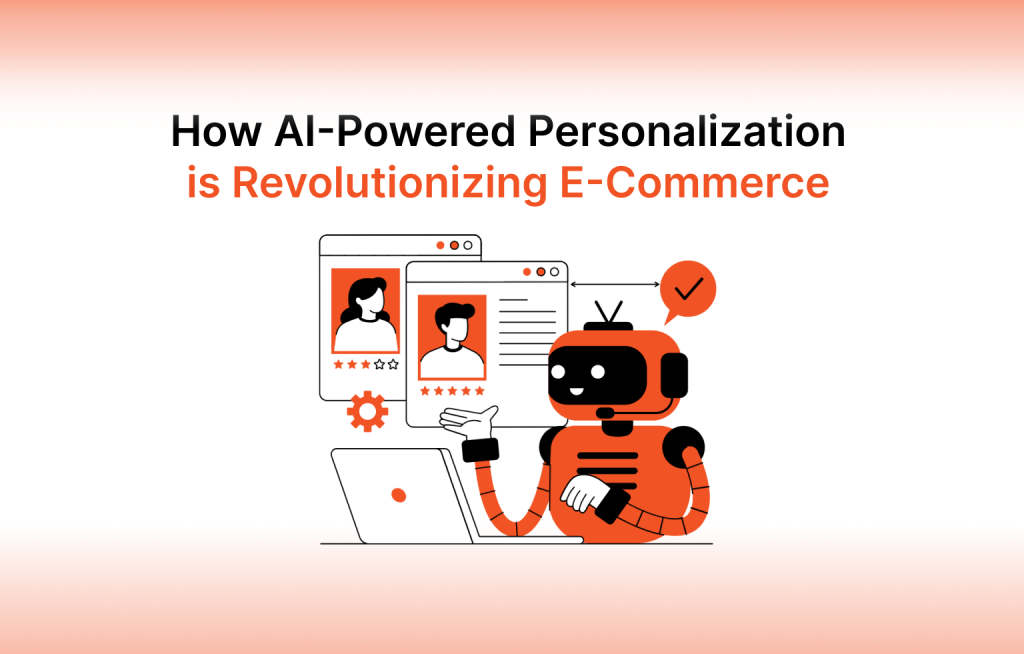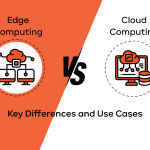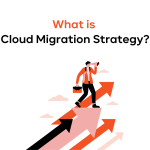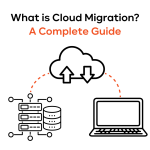Online shoppers have endless choices at their fingertips. That makes it hard for brands to stand out. But a new approach is rewriting the rules of online retail: AI personalization. This strategy breaks away from cookie-cutter ads and random recommendations. Instead, it tailors each interaction to fit a shopper’s unique preferences. By using real-time data and clever algorithms, stores can show the right product at the right moment. This makes each visit more relevant, more dynamic, and more likely to lead to a purchase. Many organizations see a big jump in loyalty and conversions when they adopt AI-powered personalization. This proves it’s not just a passing trend. It’s the new way to succeed in e-commerce.
In this article, we’ll reveal how AI and personalization work together to transform online shopping. We’ll look at real-world cases, the predictive technology behind them, and the best ways to scale these tools. We’ll also explore how AWS-based services can smooth the path to success. By the end, you’ll see why AI personalization marketing is a major leap forward for business growth. Let’s dive into the details and see how you can harness this customer-centric power right now.
Why personalization is the game-changer in retail
Competition in online retail has never been fiercer. New brands launch every day, and established retailers fight to keep their market share. At the same time, shoppers get flooded with ads and promotions. They tune out messages that aren’t relevant. That’s where AI-driven personalization comes in. It forms a deeper connection with each visitor by matching products and offers to what they actually want.
Quick overview of changing customer expectations in e-commerce
Most people now expect shopping websites to remember their likes and dislikes. An Epsilon study found that 80% of shoppers are more inclined to purchase from brands offering tailored experiences. Another Salesforce report shows shoppers grow impatient with generic ads. If an online store can’t adapt to an individual user’s needs, that user may leave and never come back.
The shift from mass-market strategies to individualized experiences
Old retail methods often relied on broad segmentation. Brands would group shoppers by age or location and then send the same email to everyone in that segment. But that doesn’t reflect each individual shopper’s tastes. AI personalization offers a new path. It responds in real time to each interaction, like the products clicked or the time spent on certain pages. This data helps the system deliver dynamic suggestions and offers that feel personal.
Statistics
Industry experts see a clear link between AI personalization and better revenue. Adobe reports that tailored campaigns can boost online sales by up to 20%. Homepages with personalization are able to raise session duration by at least 15%. Meanwhile, Gartner notes that many top retailers see a 15% jump in profitability after rolling out AI personalization marketing. These stats show that users respond to content crafted for them, and brands profit from it.
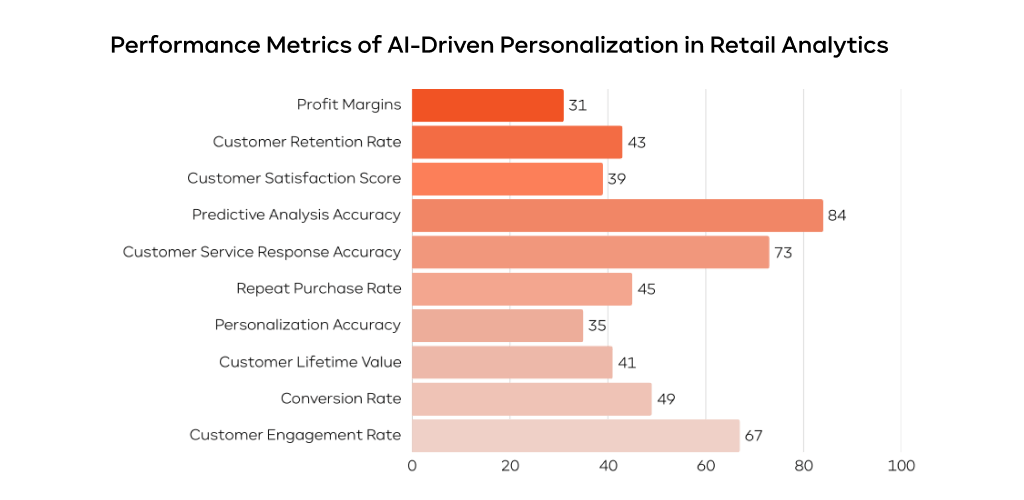
AI-powered personalization with scalable cloud infrastructure
Cloud services like AWS let you handle huge data loads for AI tasks without upfront hardware costs. Auto-scaling meets traffic spikes head-on. Pay-as-you-go pricing eases budget concerns. This is vital for organizations with big peaks in online visitors during holidays or flash sales. It means your website stays fast and your personalization AI keeps working, no matter how many people flood your store at once.
Traditional e-commerce vs. AI-personalized journeys
Many online shops still rely on old systems that treat every shopper the same. This often leads to missed chances for better engagement. AI changes that by learning from every click. It stays alert to each shopper’s preferences and adjusts in real time.
How rule-based systems and static segmentation fall short
Basic rules like “If a shopper looks at men’s shoes, show them more men’s shoes” can’t capture each user’s full interest. They also don’t adapt. A returning user might change shopping habits, but static rules won’t notice. In contrast, personalization AI reacts to each user’s current actions. It blends real-time signals with past data, giving more accurate recommendations.
Imagine a men’s clothing store with a rule-based system that shows running shoes after a visitor checks any sport item. But what if the shopper actually wants casual sneakers? They end up seeing the wrong type. AI for personalization looks deeper. It checks the styles they’ve viewed, dwell time on certain models, and user feedback. Then it shows the exact sneakers they’re likely to buy.
Common pain points
Traditional e-commerce journeys often cause the following problems:
- Cart abandonment: Irrelevant deals might push users away.
- Weak retention: Without a personal touch, shoppers lose interest.
- Low conversions: Generic landing pages and CTAs fail to inspire action.
These pain points motivate retailers to look for new ways. And this is where AI personalization makes a difference.
Why real-time behavioral data and predictive modeling matter
AI in e-commerce relies on live user actions. It notes clicks, time spent on a page, and items added or removed from the cart. Then it predicts what someone might do next. Collaborative filtering helps match similar shoppers. Natural Language Processing (NLP) refines site search by analyzing context. This dynamic approach uncovers hidden insights and offers them at the perfect moment.
What AI-powered personalization really means
AI personalization is much deeper than pre-set rules and old-fashioned suggestion systems. It’s a cycle of data collection, analysis, and action. Each step refines what shoppers see and helps them discover items they want.
Definitions and core concepts
At its foundation, AI uses data-driven models that learn and improve as they process more information. In the realm of AI-powered personalization, these models detect patterns in user behavior, brand catalogs, and external data sources.
User profiling
User profiling involves building a unique identity for each shopper. It tracks details like past purchases, browsing history, device type, and location. If someone shops often on weekdays after work, the system can show fresh product lines or special deals at that time. That way, each interaction becomes more personal.
Behavioral targeting
Behavioral targeting bases recommendations on what shoppers do, not just who they are. It watches patterns like repeated visits to a certain category. Then, it uses AI for content personalization based on that information. This strategy often outperforms simple demographic-based ads because it focuses on actual user habits.
Recommendation systems
These systems are the engines behind suggestions such as “You might also like…” or “People who bought this also bought….” They use matrix factorization, deep learning, and content-based filters to find ties between items and people. By detecting common user journeys, these algorithms serve new products or add-ons that match the shopper’s history.
Real-time vs. batch personalization
- Batch personalization: Updates user segments on a set schedule, like daily or weekly. This fits big promotions, but can’t pivot fast if a user changes habits overnight.
- Real-time personalization: Reacts the moment a user clicks, scrolls, or adds an item. It might change recommended products or adjust site banners at once. This approach yields stronger engagement and better conversions.
The role of data: structured, semi-structured, and unstructured
Data doesn’t all look the same. When you personalize AI, it needs many kinds:
- Structured: Tidy data with rows and columns (e.g., product IDs, prices).
- Semi-structured: Web logs or JSON records that have patterns but no fixed format.
- Unstructured: User reviews or images, which need special handling.
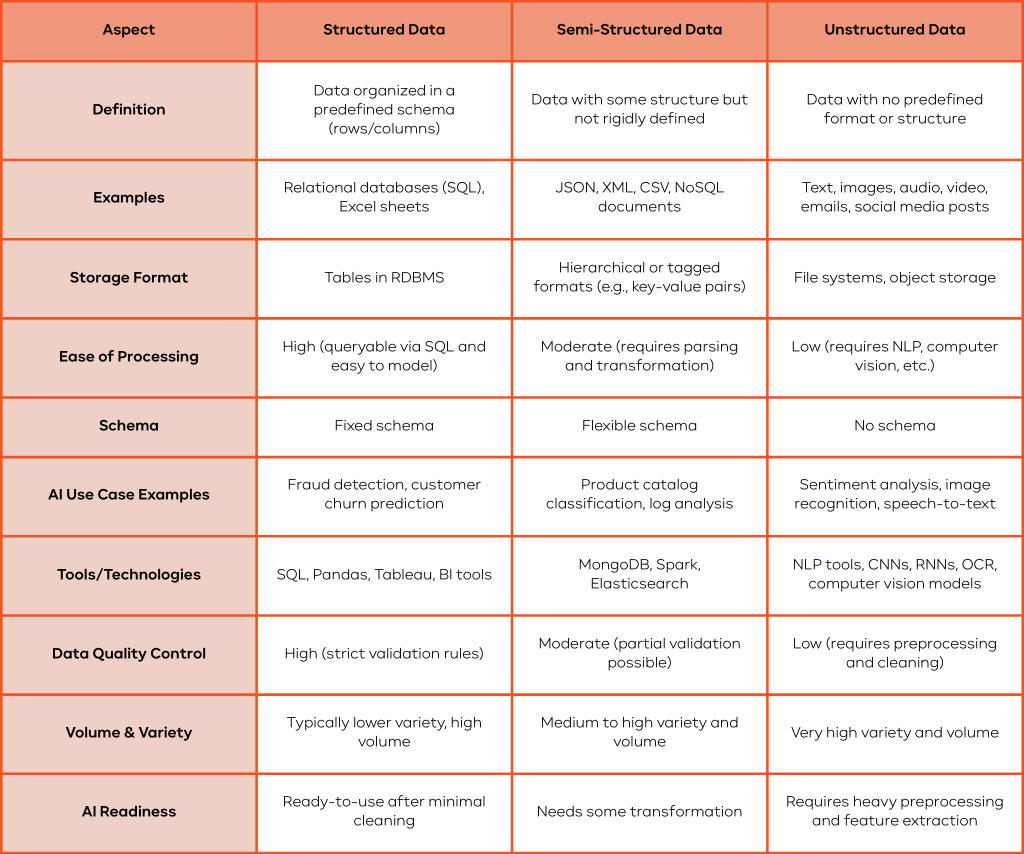
Tools like S3, Redshift, and Glue on AWS make it easier to manage these data types. They also automate parts of the process. That helps organizations get data ready for training models.
Key use cases for AI in personalization
Retailers can apply AI-based personalization at many points along the shopper’s path. Each step aims to match content or offers to real user desires.
Product recommendations
Common lines like “Based on your browsing history…” or “Customers who bought this also bought…” are powered by these algorithms. For instance, Amazon Personalize uses collaborative filtering to analyze patterns at scale. By connecting past behavior with similar user profiles, it offers the items most likely to spark a purchase.
Personalized landing pages and emails
Some sites customize the entire homepage for each user. For example, if someone loves sports gear, the first banner might show new running shoes. Emails also adapt by highlighting deals or promotions for products users recently viewed. This personal spin can lead to higher open rates and better click-throughs.
Search results tailored by user intent
Standard site searches often fail to handle slang, synonyms, or vague queries. AI can decode these and show better matches. For instance, if someone types “cozy sneakers,” the system might show them plush, comfortable footwear. Traditional search might not catch that nuance. By understanding user intent, the system returns results that feel more relevant.
Personalized pricing and promotions
Some retailers adjust prices or deals in real time. If a user has items in their cart for days, the system might display a slight discount to close the sale. By spotting when a shopper is “on the fence,” these algorithms step in with tempting offers.
Loyalty programs with ML-based triggers
Machine learning can predict when a user is close to leaving. It can then trigger loyalty rewards or special emails to encourage them to stay. If a shopper’s visits drop off, the system sends a renewal offer or a “we miss you” note. This approach keeps loyal users engaged and prevents them from leaving.
_______________________________________________________________________
Want to launch a tailored shopping experience that wows your visitors?
Our experts can help you create a solid, scalable plan for AI success.
_______________________________________________________________________
AWS services that power AI personalization
AWS has a full range of tools to run AI personalization. These cover data storage, model building, real-time recommendations, and messaging.
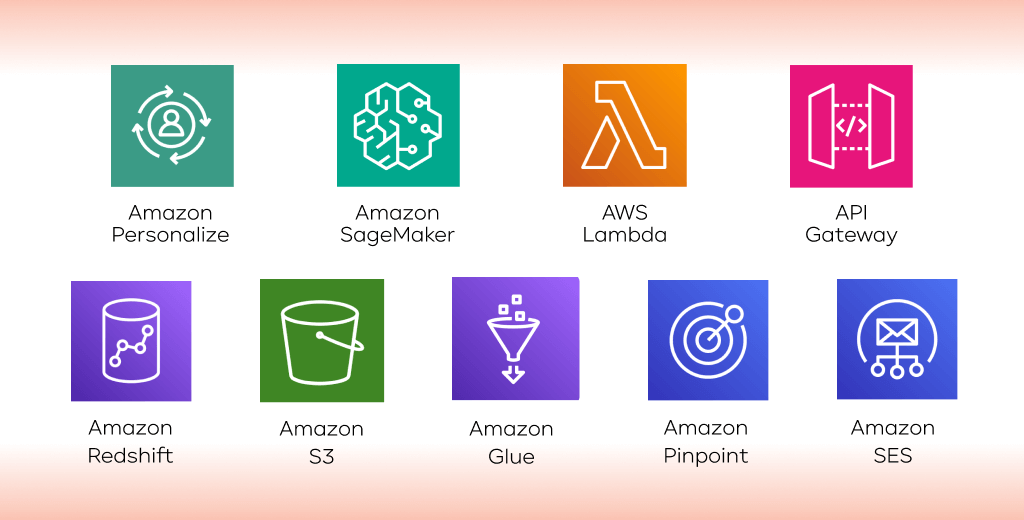
Amazon Personalize
This service is a good entry point for AI personalization. It includes collaborative filtering, automated training, and easy deployment. You don’t need a PhD in machine learning. You just import data, choose objectives, and let the service train your model.
Amazon SageMaker
For teams needing more control, SageMaker is a complete platform to build, train, and deploy custom models. Data scientists can code advanced algorithms or rely on built-in methods. It integrates with other AWS tools like S3 or Lambda, making large-scale projects more straightforward.
AWS Lambda + API Gateway
You often need quick responses for real-time personalization. Lambda runs your code on demand, and API Gateway routes incoming calls. When a user loads a page, the site can call a Lambda function that fetches fresh recommendations. This cuts down on wait times and avoids the need to manage servers.
Amazon Redshift / S3 / Glue
These services support your data pipeline. S3 stores raw and processed data. Redshift is a data warehouse that handles analytics. Glue automates data prep tasks like cleaning and cataloging. Together, they form a system where you can process huge amounts of user data for AI personalization.
Amazon Pinpoint or SES
AI-powered personalization doesn’t stop at your website. Pinpoint can personalize push notifications or SMS campaigns. Amazon SES (Simple Email Service) is great for sending large volumes of targeted emails. By linking them with your AI model, you can deliver the right message at the right time.
Compare Personalize with other frameworks
Other players include Google Recommendations AI and Salesforce Einstein. Each has unique features. But Amazon Personalize ties in well with the AWS ecosystem, offering better integration if your systems already run on AWS. You also pay only for what you use, which may cut costs and risk.
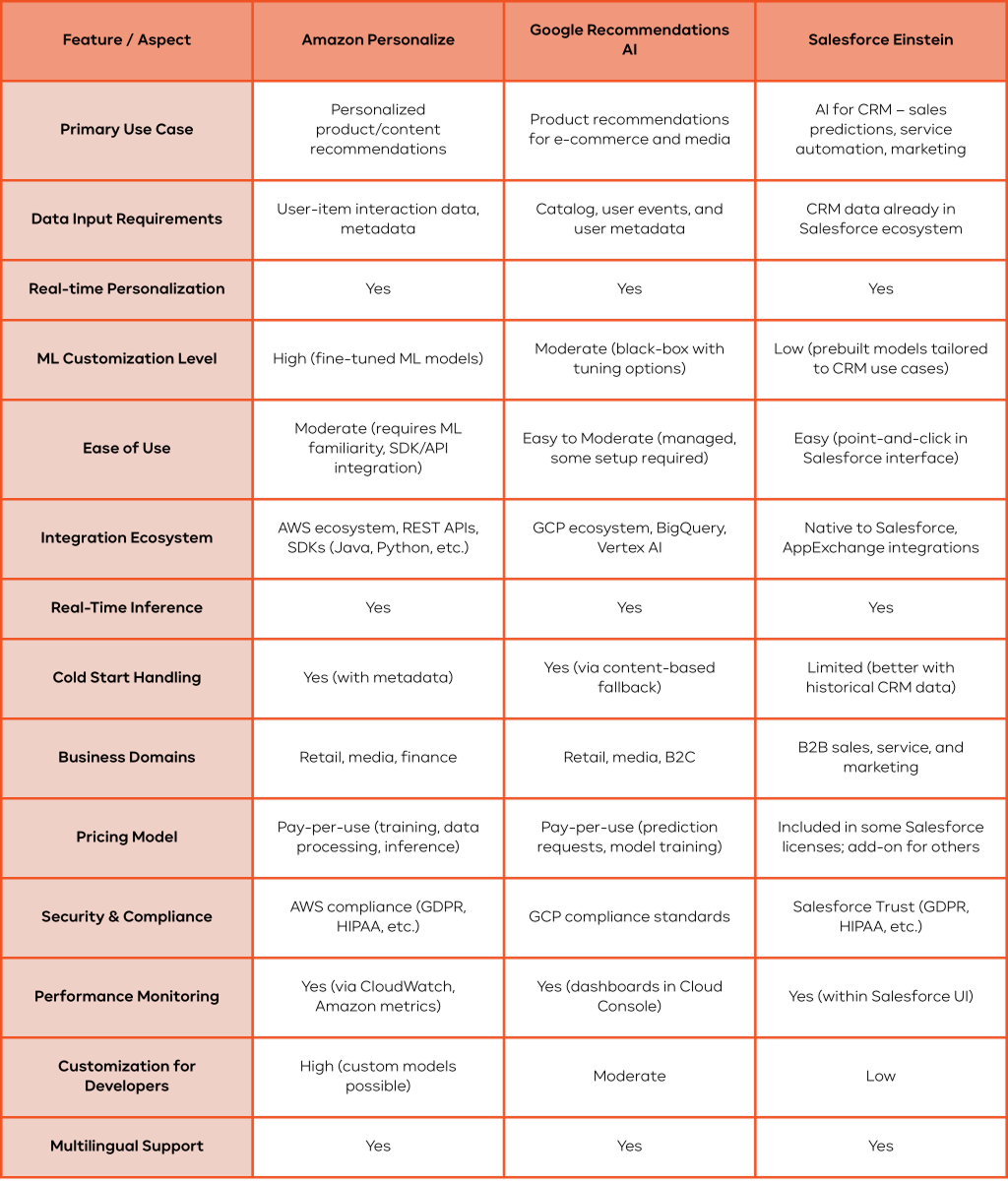
How we deliver personalization projects at IT-Magic
At IT-Magic, we guide business clients from the early stages of data prep to the final rollout. Our method ensures each project stays secure, stable, and aligned with company goals.
Architecture blueprint: fine-tuning → delivery
Here’s our typical process:
- Data ingestion and preparation: We collect data (structured, semi-structured, unstructured) into S3 or Redshift. Glue cleans and organizes this data.
- Model selection and fine-tuning: We might use Amazon Personalize for straightforward setups or SageMaker for custom needs. Our team tests the model with actual user segments to confirm accuracy.
- Deployment: We host real-time inference endpoints via AWS Lambda and API Gateway. This allows immediate and scalable recommendations.
- Monitoring and iteration: We track performance, collect feedback, and tweak models regularly. This keeps the personalization engine in sync with real-world changes.
Security-first design
Protecting customer data is a top priority. We use AWS features like encryption at rest, encryption in transit, IAM controls, and compliance frameworks (PCI DSS, GDPR, etc.). We follow the principle of least privilege: only authorized staff can access sensitive info. This builds a robust shield against data leaks or breaches.
CI/CD and DevOps: automating model fine-tuning and deployment
We streamline updates with tools like SageMaker Pipelines, GitHub Actions, and Terraform. These help us automate code checks, run tests, and roll out new versions. If the system notices changes in user trends, a new model can be trained and pushed live without long delays. This ensures your AI remains fresh and effective.
Measuring success and ROI
Personalization isn’t just a buzzword. It should show clear returns. You’ll want to track specific metrics to confirm your strategy is paying off.
Key metrics
- Click-through rate (CTR): Measures how often users click on your personalized suggestions.
- Conversion rate (CVR): Tracks completed purchases after seeing customized offers.
- Lifetime value (LTV): Shows the total revenue a customer generates over time.
- Net promoter score (NPS): Gauges how likely users are to recommend you.
- Retention rate: Measures how often shoppers come back after their first purchase.
Evaluating new vs. returning users can uncover which group benefits most from your personalization efforts.
How AI reduces time-to-value
Manual experiments might take weeks to decide which option works best. AI can speed this up by automatically testing and refining. If a certain product combination boosts conversions by 30%, it detects that pattern sooner. That means you start seeing results faster.
Cost analysis
Setting up AI personalization requires an investment in data gathering, cloud resources, and skill. Yet the long-term gains often outweigh the upfront costs. You automate tasks that staff might do manually, like drafting segmented emails. With AWS pay-as-you-go models, you can scale costs in line with your traffic.
Challenges & considerations
Personalization isn’t a magic bullet. It has its complications. Anticipating these issues helps keep your project on track.
Cold start problem and how to mitigate it
New stores or newly added products might have little data for AI to learn from. AI can guess user preferences based on small hints, like demographic insights or general bestsellers. After you gather enough interactions, the recommendations become more accurate. Starting small, like focusing on top-performing categories, can also help you ramp up fast.
Data privacy
Customer data must be handled with care. That includes anonymization, data residency rules, and region-specific standards like GDPR or CCPA. AWS supports encryption keys (KMS) and secure transport (SSL/TLS). We also configure tight IAM roles, so only those who need the data can access it.
Managing model drift and retraining frequency
Trends can shift. A product that sells well this month might flop next month. Regular retraining keeps the model aligned with real shopping behavior. Many retailers opt for daily or weekly refreshes. Others wait for performance triggers to prompt a retrain. In either case, plan for this step to stay ahead of the curve.
Avoiding personalization fatigue
Too many targeted messages can annoy shoppers. If they are bombarded with push notifications and feel pressure, they might opt out. Balance is key. It’s also smart to introduce variety – maybe show a new collection once in a while. Testing different messages with a control group can ensure you’re not overdoing it.
Final thoughts: why it’s time to embrace AI-driven personalization
Online buyers crave a sense that brands understand them. AI-driven personalization meets that need by using live data and predictive insights. This method lifts sales, boosts loyalty, and keeps you agile in a fierce market. It doesn’t just help you stand out – it helps you evolve with each user’s needs.
Summary of benefits
- Higher conversions thanks to relevant product offers
- Greater brand loyalty because shoppers feel valued
- Smarter marketing spend, since you focus on what works
- Real-time updates that let you pivot when user patterns change
Strategic advice
Start simple. You might begin with recommended products or personalized email subject lines. Track your performance, then expand. Over time, you can add dynamic pricing, advanced loyalty triggers, or real-time AI-personalized content changes on your homepage. Working with a specialized partner like IT-Magic helps you dodge pitfalls and keep sight of your core business goals.
AI personalization taps into modern algorithms, real-time interaction data, and cloud scalability to engage each customer in a unique way. By weaving in predictive logic and swift feedback loops, you can create a shopping journey that feels tailored to each individual. The payoff is better conversions, deeper loyalty, and a brand that grows alongside its audience. That is the core promise of AI content personalization – and it’s getting more powerful every day.
Contact us to assess your readiness and see what a tailored solution looks like
Interested in AI personalization that sets your brand apart? Our team can help you look at your data, spot quick wins, and plan a roadmap for advanced features, and build these systems with clear goals.
FAQ
Why are traditional personalization methods no longer effective?
Outdated methods rely on broad segments or old rules. They don’t adjust quickly if a user’s tastes change. Modern shoppers expect dynamic and relevant offers, which require real-time data analysis and predictive modeling. Legacy setups can’t keep up with that pace, and artificial intelligence personalization can.
How does AI help reduce cart abandonment and increase conversions?
When a user is on the fence, AI can sense it. The system might show a small promo or remind them about an item’s limited stock. By knowing their browsing pattern, it can react in the moment to spark a sale. This kind of gentle nudge often leads to more completed checkouts.
How do companies manage data privacy while using AI for personalization?
AWS services have features like data encryption, multi-factor authentication, and region-based hosting. At IT-Magic, we also use strict IAM controls, so only approved staff can see sensitive records. We follow all local privacy laws, which helps you stay compliant while still delivering relevant user experiences.
What are some common pitfalls to avoid in personalization projects?
- Bad data or missing user records.
- Sending too many targeted messages, causing annoyance.
- Creating models that don’t meet your business goals.
- Neglecting ongoing monitoring and retraining, leading to outdated predictions.
